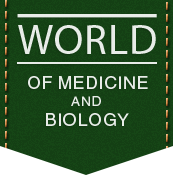| About the author: |
O. Y. Akimov, A. O. Mykytenko, V. O. Kostenko, G. A. Yeroshenko |
| Heading |
EXPERIMENTAL MEDICINE |
| Type of article |
Scentific article |
| Annotation |
Metabolic syndrome, despite being a disease of non-infectious origin, is often accompanied by inflammation induced by metabolic disorders (meta-inflammation). The purpose of this work is to determine the activity of antioxidant enzymes, the production of superoxide anion radical, the content of oxidatively modified proteins and the concentration of malondialdehyde in the heart of rats under conditions of experimental metabolic syndrome and ammonium pyrrolidine dithiocarbamate administration. The study was conducted on 24 mature male Wistar rats weighing 200-260 g. The animals were divided into 4 groups of 6 animals each: control group; metabolic syndrome group (metabolic syndrome was reproduced by using a 20 % fructose solution as the only source of water for 60 days); ammonium pyrrolidinedithiocarbamate administration group (i.p. 76 mg/kg thrice a week for 60 days), and group of ammonium pyrrolidinedithiocarbamate administration on the background of metabolic syndrome modeling. Metabolic syndrome leads to development of oxidative stress in rat heart, which is characterized by excessive production of reactive oxygen species and insufficiency of antioxidant defense. Ammonium pyrrolidine dithiocarbamate administration decreased superoxide production by 55.44 %, increased superoxide dismutase and catalase activity by 156.32 % and 111.44 %, respectively, and decreased concentration of malondialdehyde by 22.41 %. Administration of blocker of NF-κB activation (ammonium pyrrolidinedithiocarbamate) during modeling of metabolic syndrome limits excessive production of reactive oxygen species and intensity of lipid peroxidation, while increasing antioxidant defense of rat heart. |
| Tags |
metabolic syndrome,heart,NF-κB,ammonium pyrrolidinedithiocarbamate,oxidative stress |
| Bibliography |
- Aboonabi A, Aboonabi A. Anthocyanins reduce inflammation and improve glucose and lipid metabolism associated with inhibiting nuclear factor-kappaB activation and increasing PPAR-γ gene expression in metabolic syndrome subjects. Free Radic Biol Med. 2020; 150: 30–39. doi: 10.1016/j.freeradbiomed.2020.02.004.
- Akhter N, Wilson A, Arefanian H, Thomas R, Kochumon S, Al-Rashed F, et al. Endoplasmic Reticulum Stress Promotes the Expression of TNF-α in THP-1 Cells by Mechanisms Involving ROS/CHOP/HIF-1α and MAPK/NF-κB Pathways. Int J Mol Sci. 2023; 24(20): 15186. doi: 10.3390/ijms242015186.
- Bjørklund G, Dadar M, Pivina L, Doşa MD, Semenova Y, Aaseth J. The Role of Zinc and Copper in Insulin Resistance and Diabetes Mellitus. Curr Med Chem. 2020; 27(39): 6643–6657. doi: 10.2174/0929867326666190902122155.
- Chen J, Jiang Y, Shi H, Peng Y, Fan X, Li C. The molecular mechanisms of copper metabolism and its roles in human diseases. Pflugers Arch. 2020; 472(10): 1415–1429. doi: 10.1007/s00424-020-02412-2.
- Gaál A, Orgován G, Mihucz VG, Pape I, Ingerle D, Streli C, et al. Metal transport capabilities of anticancer copper chelators. J Trace Elem Med Biol. 2018; 47: 79-88. doi: 10.1016/j.jtemb.2018.01.011.
- Gargiulo P, Marsico F, Renga F, Dell'Aversana S, Esposito I, Marciano C, et al. The metabolic syndrome in heart failure: insights to specific mechanisms. Heart Fail Rev. 2020; 25(1): 1–7. doi: 10.1007/s10741-019-09838-6.
- Kostenko V, Akimov O, Gutnik O, Kostenko H, Kostenko V, Romantseva T, et al. Modulation of redox-sensitive transcription factors with polyphenols as pathogenetically grounded approach in therapy of systemic inflammatory response. Heliyon. 2023; 9(5): e15551. doi: 10.1016/j.heliyon.2023.e15551.
- Li X, Zhang F, Zhou H, Hu Y, Guo D, Fang X, et al. Interplay of TNF-α, soluble TNF receptors and oxidative stress in coronary chronic total occlusion of the oldest patients with coronary heart disease. Cytokine. 2020; 125: 154836. doi: 10.1016/j.cyto.2019.154836.
- Li Y, Qiao Y, Wang H, Wang Z. Intraperitoneal injection of PDTC on the NF-kB signaling pathway and osteogenesis indexes of young adult rats with anterior palatal suture expansion model. PLoS One. 2021; 16(7): e0243108. doi: 10.1371/journal.pone.0243108.
- Mamikutty N, Thent ZC, Sapri SR, Sahruddin NN, Mohd Yusof MR, Haji Suhaimi F. The establishment of metabolic syndrome model by induction of fructose drinking water in male Wistar rats. Biomed Res Int. 2014; 2014: 263897. doi: 10.1155/2014/263897.
- Masenga SK, Kabwe LS, Chakulya M, Kirabo A. Mechanisms of Oxidative Stress in Metabolic Syndrome. Int J Mol Sci. 2023; 24(9): 7898. doi: 10.3390/ijms24097898.
- Mili N, Paschou SA, Goulis DG, Dimopoulos MA, Lambrinoudaki I, Psaltopoulou T. Obesity, metabolic syndrome, and cancer: pathophysiological and therapeutic associations. Endocrine. 2021; 74(3): 478–497. doi: 10.1007/s12020-021-02884-x.
- Mykytenko AO, Akimov OYe, Yeroshenko GA, Neporada KS. Influence of NF-κB on the development of oxidative-nitrosative stress in the liver of rats under conditions of chronic alcohol intoxication. Ukr. Biochem. J. 2022; 94(6): 57–66. doi: 10.15407/ubj94.06.057.
- Nicoară DM, Munteanu AI, Scutca AC, Mang N, Juganaru I, Brad GF, et al. Assessing the Relationship between Systemic Immune-Inflammation Index and Metabolic Syndrome in Children with Obesity. Int J Mol Sci. 2023; 24(9): 8414. doi: 10.3390/ijms24098414.
- Satoh T, Wang L, Espinosa-Diez C, Wang B, Hahn SA, Noda K, et al. Metabolic Syndrome Mediates ROS-miR-193b-NFYA-Dependent Downregulation of Soluble Guanylate Cyclase and Contributes to Exercise-Induced Pulmonary Hypertension in Heart Failure With Preserved Ejection Fraction. Circulation. 2021; 144(8): 615–637. doi: 10.1161/CIRCULATIONAHA.121.053889.
|
| Publication of the article |
«World of Medicine and Biology» №1(87), 2024 year, 178-182 pages, index UDK 616.12:616.89:612.015.3:612.08.599.323.4 |
| DOI |
10.26724/2079-8334-2024-1-87-178-182 |
